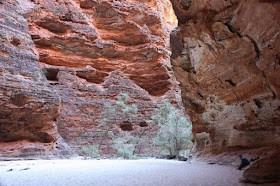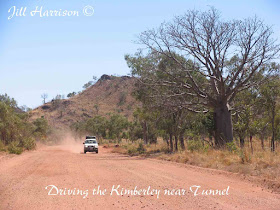Cathedral Gorge is well named. Entering its immense towering cavern is like entering a magnificent natural cathedral, a place steeped in time and history. The red and orange sandstone walls tower above you, and the white sand crunches softly underfoot. Tiny tracks from night time animals can be seen going across the sand to the central pool which sits still and undisturbed like a mirror. It is a place for hushed voices and to sit quietly with your own thoughts. If you come early in the morning, as we did, you can enjoy the peace undisturbed. It has the atmosphere of a holy place, a sanctuary
Cathedral Gorge is just one of the magnificent gorges within the Purnululu National Park (also known as the Bungle Bungles) in the Kimberley region in Western Australia’s far north west. Given World Heritage listing in 2003, Purnululu is one of Western Australia’s newest and most spectacular National Parks.
In the Kija Aboriginal language purnululu means sandstone. The Aboriginal people inhabited the region for thousands of years, however Purnululu was known only to a few Europeans until the mid 1980s.
How it received the name Bungle Bungles remains an intriguing mystery with several explanations including the corruption of the Aboriginal name Purnululu, or derived from the name of a common Kimberley grass, bundle bundle grass, or the ranges proximity to the old Bungle Bungle cattle station.

Purnululu is located off the Great Northern Highway, 250km south of Kununurra, west of the WA/Northern Territory border. There is a 53 kilometre unsealed road only accessible by 4WD and offroad campers from the Highway, through Mabel Downs Station to the Department of Environment and Conservation (DEC) Rangers / Visitor Centre and roads are unsealed throughout the Park. You should allow approximately 2-3 hours for the 53 km drive in (approximately 5 hours total travel time from Kununurra).
You can also read more about Purnululu on my blog post here -
Sunset over Spinifex in World Heritage Purnululu
and my articles in November 2011 edition of On The Road Magazine.
Sunset over Spinifex in World Heritage Purnululu
and my articles in November 2011 edition of On The Road Magazine.







